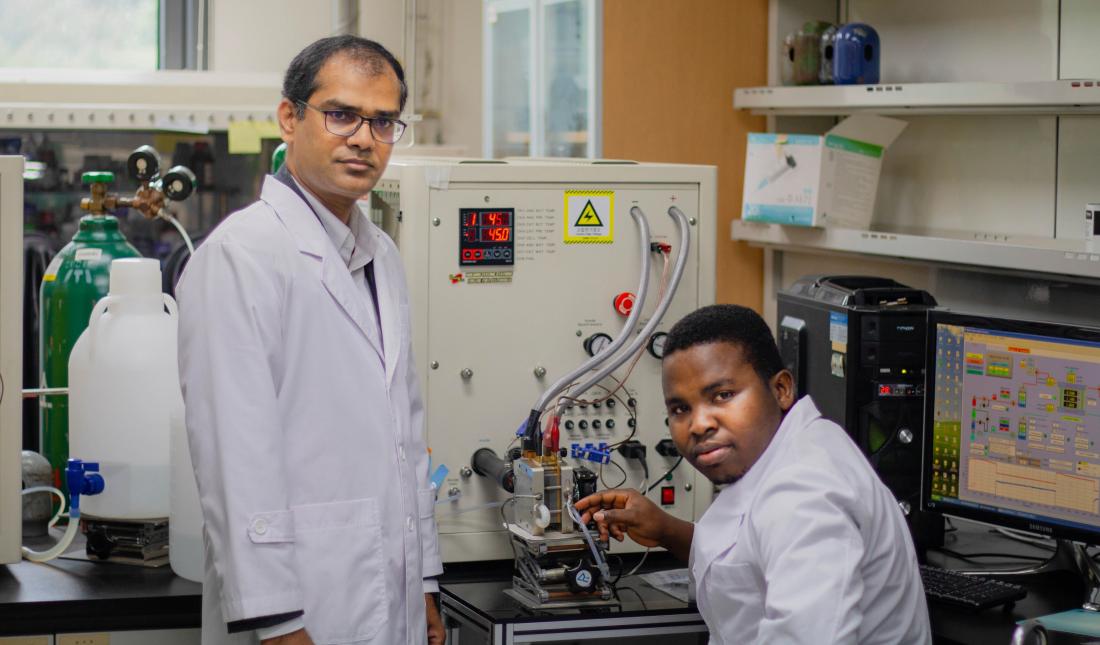Professor Sangaraju Shanmugam standing next to Mr. Maxwell Tsipoaka, Master’s degree student, at DGIST’s Energy Engineering laboratory
Many governments and large companies have placed high hopes on polymer electrolyte membrane fuel cells as a promising candidate to replace the internal combustion engine widely used in vehicles
Polymer electrolyte membrane fuel cells could soon become a green alternative to the internal combustion engine widely used in transportation. However, Nafion, the most promising membrane material to date, degrades rapidly during use. Now, scientists at DGIST, Korea, have developed a degradation-mitigating additive that makes Nafion membranes significantly more durable. Their approach paves the way to a more sustainable society with less carbon emissions and air pollution.
With greenhouse gas emissions already soaring and projected to increase in upcoming years, researchers worldwide are frantically looking for viable alternatives to one of the main culprits: the internal combustion engine widely used in transportation. A promising candidate that’s on the brink of technological readiness is the polymer electrolyte membrane fuel cell (PEMFC). These devices are electrochemical cells that generate electricity through reactions that consume hydrogen and produce only water as a byproduct. In essence, PEMFCs are energy converters that can be deployed within vehicles and other devices compatible with hydrogen as fuel.
Despite their huge potential, technical challenges still hinder the widespread adoption of PEMFCs. Nafion, one of the best materials available for the polymer electrolyte membrane of PEMFCs, degrades rather rapidly when dry and at high temperature; these are, sadly, Nafion’s normal operating conditions. Fortunately, a team of scientists led by Professor Sangaraju Shanmugam from Daegu Gyeongbuk Institute of Science and Technology (DGIST), Korea, have recently reported an efficient way to tackle this problem.
They theorized that the degradation of Nafion could be drastically reduced if the very chemical mechanisms behind this degradation could be stopped or mitigated right at the membrane. To achieve this, the scientists crafted an additive out of cerium–titanium oxide nanoparticles, which combat dryness by absorbing water and prevent degradation by capturing defect-inducing chemical radicals like hydride (OH−). The nanoparticles were dispersed in the Nafion membrane both loosely (on their own) and uniformly contained within carbon nanofibers.
By introducing this novel additive to the fuel cell’s electrolyte, its degradation was reduced by about two orders of magnitude and its durability increased to over 400 hours, surpassing that of other state-of-the-art Nafion membranes! “Our findings validate the rationale of combining Nafion with degradation-mitigating additives as a way to extend the lifespan of the fuel cell’s membrane,” remarks Shanmugam, “This approach should help minimize or even eliminate the current costs of membrane humidification, taking us yet another step closer to a green energy economy.”
Shanmugam and his team believe that the adoption of PEMFCs as energy conversion devices for hydrogen derived from clean sources will have a tremendously positive impact in many regards. “The problems associated with petroleum-based energy consumption, including air pollution, greenhouse-gas emissions, and economic dependence on petroleum, can be reduced drastically by switching from the internal combustion engine to PEMFCs,” explains the Professor. Their study was approved for publication in the Sustainable Chemistry and Engineering journal of the prestigious American Chemical Society, and a patent application was successfully filed as well. Let us hope these confident strides towards sustainable technologies will help us secure a better future for ourselves and the generations to come.
Reference
|
Authors: |
Maxwell Tsipoaka, Md. Abdul Aziz, and Sangaraju Shanmugam |
|
Title of original paper: |
Degradation-Mitigating Composite Membrane That Exceeds a 1 W cm−2 Power Density of a Polymer Electrolyte Membrane Fuel Cell Operating Under Dry Conditions |
|
Journal: |
ACS Sustainable Chemistry and Engineering |
|
DOI: |
10.1021/acssuschemeng.0c07846 |
|
Affiliations: |
Department of Energy Science & Engineering, Daegu Gyeongbuk Institute of Science & Technology (DGIST) |
*Corresponding author’s email: [email protected]
About Daegu Gyeongbuk Institute of Science and Technology (DGIST)
Daegu Gyeongbuk Institute of Science and Technology (DGIST) is a well-known and respected research institute located in Daegu, Republic of Korea. Established in 2004 by the Korean Government, the main aim of DGIST is to promote national science and technology, as well as to boost the local economy.
With a vision of “Changing the world through convergence", DGIST has undertaken a wide range of research in various fields of science and technology. DGIST has embraced a multidisciplinary approach to research and undertaken intensive studies in some of today's most vital fields. DGIST also has state-of-the-art-infrastructure to enable cutting-edge research in materials science, robotics, cognitive sciences, and communication engineering.
Website: https://www.dgist.ac.kr/en/html/sub01/010204.html
About the author
Professor Sangaraju Shanmugam obtained a PhD on heterogenous catalysis from the Indian Institute of Technology, Madras, India, in 2004. He then worked as a postdoctoral fellow in 2005 in Bar-Ilan University, Israel, and as a JSPS postdoctoral fellow at Waseda University, Japan, in 2007. In 2011, he was appointed as Assistant Professor at DGIST, Korea, where he now serves as Professor. Shanmugam currently has 132 refereed publications to his credit and five Indian Patents, and he has filed twelve Korean patents. His current research interests include the development of cost-effective yet durable electrode materials for polymer electrolyte membrane fuel cells and their applications towards energy conversion and storage devices.




